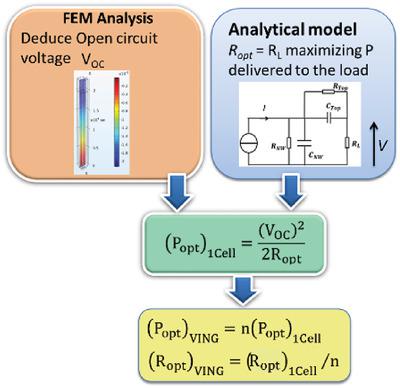当前位置:
X-MOL 学术
›
Adv. Theory Simul.
›
论文详情
Our official English website, www.x-mol.net, welcomes your
feedback! (Note: you will need to create a separate account there.)
Effect of the Dielectric and Mechanical Properties of the Polymer Matrix on ZnO‐Nanowire‐Based Composite Nanogenerators Performance
Advanced Theory and Simulations ( IF 2.9 ) Pub Date : 2020-08-13 , DOI: 10.1002/adts.202000128 Nicole Doumit 1 , Guylaine Poulin‐Vittrant 1
Advanced Theory and Simulations ( IF 2.9 ) Pub Date : 2020-08-13 , DOI: 10.1002/adts.202000128 Nicole Doumit 1 , Guylaine Poulin‐Vittrant 1
Affiliation

|
The effect of Young's modulus and dielectric permittivity of the polymer matrix in vertically integrated nanogenerators (VING) on their output performance is studied by combining the finite element method and analytical modeling. To conduct this study, an elementary cell is considered, based on one ZnO nanowire (NW) surrounded by the polymer matrix. It is demonstrated that the polymer matrix should have the lowest Young's modulus and permittivity as possible, in order to maximize the output voltage and power. Four different materials, which have already been proposed in literature for such composite VING, are then compared: Parylene C, poly(methyl methacrylate), Al2O3, and poly(dimethylsiloxane) (PDMS). Simulation results show that PDMS, which has the lowest values of both Young's modulus and permittivity, gives the highest output performance. Finally, the sensitivity to another design parameter—the surface density of the NWs—is calculated, and it is shown that choosing a polymer material with the lowest Young's modulus and permittivity is more powerful to improve the VING performance.
中文翻译:

聚合物基体的介电和机械性能对基于ZnO-纳米线的复合纳米发电机性能的影响
结合有限元方法和解析模型,研究了垂直集成纳米发电机(VING)中聚合物基体的杨氏模量和介电常数对其输出性能的影响。为了进行这项研究,考虑了一种基于被聚合物基质包围的ZnO纳米线(NW)的基本电池。已经证明,聚合物基体应该具有最低的杨氏模量和介电常数,以便使输出电压和功率最大化。然后比较了文献中已针对这种复合VING提出的四种不同材料:聚对二甲苯C,聚甲基丙烯酸甲酯,Al 2 O 3,以及聚二甲基硅氧烷(PDMS)。仿真结果表明,具有最小杨氏模量和介电常数值的PDMS可以提供最高的输出性能。最终,计算了对另一个设计参数(NW的表面密度)的敏感性,结果表明,选择杨氏模量和介电常数最低的聚合物材料对改善VING性能具有更大的作用。
更新日期:2020-09-23
中文翻译:

聚合物基体的介电和机械性能对基于ZnO-纳米线的复合纳米发电机性能的影响
结合有限元方法和解析模型,研究了垂直集成纳米发电机(VING)中聚合物基体的杨氏模量和介电常数对其输出性能的影响。为了进行这项研究,考虑了一种基于被聚合物基质包围的ZnO纳米线(NW)的基本电池。已经证明,聚合物基体应该具有最低的杨氏模量和介电常数,以便使输出电压和功率最大化。然后比较了文献中已针对这种复合VING提出的四种不同材料:聚对二甲苯C,聚甲基丙烯酸甲酯,Al 2 O 3,以及聚二甲基硅氧烷(PDMS)。仿真结果表明,具有最小杨氏模量和介电常数值的PDMS可以提供最高的输出性能。最终,计算了对另一个设计参数(NW的表面密度)的敏感性,结果表明,选择杨氏模量和介电常数最低的聚合物材料对改善VING性能具有更大的作用。









































 京公网安备 11010802027423号
京公网安备 11010802027423号